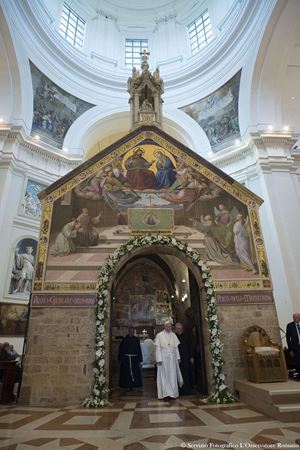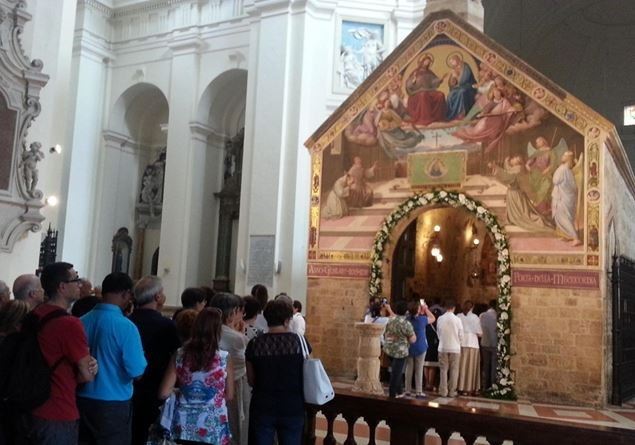The majestic basilica of Santa Maria degli Angeli in Porziuncola, Built on the interest of S. Pio V starting from 1569 and which stands about four kilometers from Assisi, the ancient chapel of the Porziuncola, linked to the memory of San Francesco d’Assisi, contains among its walls. Today on his facade there is a fresco depicting the establishment of the Forgiveness of Assisiwork of GF Overbek of Lubecca (1829-1830), who thus wanted to decorate that insignificant place.
How did the “forgiveness of Assisi” come about?
Precisely to Porziuncola the saint of Assisi had the divine inspiration to ask the Pope the indulgence that was then said, in fact, “of Porziuncola or great forgiveness“, Whose party is celebrated on August 2nd.
It is the diploma of fr. Teobaldo, bishop of Assisi, one of the most popular documents, to report it. S. Francesco, in an unspecified night of July 1216, while he was on his knees before the small altar of the Porziuncola, immersed in prayer, he suddenly saw a blazing clear light illuminating the walls of the humble church. Sitting on the throne, surrounded by a crowd of angels, in an sparkling light, Jesus and Mary appeared. The Redeemer asked his servant what grace he wished for the good of men. S. Francesco humbly replied: “Since he is a miserable sinner who speaks to you, or merciful God, he asks you pity for his sinners brothers; and all those who, repentant, will cross the thresholds of this place, have lords from you, who see their torments, the forgiveness of the faults committed“.
“What you ask, or friar Francesco, is great – the Lord said to him -, but you will have more worthy things and you will have. So I welcome your prayer, but as long as you ask my vicar on the ground, on my part, this indulgence”.
Giotto, Francesco Predico in front of Honorio III, Basilica Superiore of Assisi
The request to Pope Honorius III
At the first light of dawn, therefore, Francesco, taking with him only friar Masseo of Marignano, headed towards Perugia, where the Pope was then located. He sat on the spide of Peter, after the death of the great Innocenzo III, Pope Honorior IIIelderly but very good and pious man, who had given what he had to the poor. The Pope, listened to the story of the vision from the Mouth of the Poverello of Assisi, asked how many years he asked for this indulgence.
Francesco replied that he asked “not years, but anime” And that he wanted “that anyone who will come to this confessed and contrite church is acquitted by all his sins, by fault and penalty, in heaven and on the ground, from the day of baptism to the sideways to the day and the hour that he will end up in the said church”. It was an unusual request, given that such indulgence used to grant it only for those who took the cross for the liberation of the Holy Sepulcher, becoming crusaders.
The Pope, in fact, pointed out to the Poverello that “it is not a custom of the Roman court to grant a similar indulgence”. Francesco replied: “What I ask, is not on my part, but on the part of the one who sent me, that is, our Lord Jesus Christ“Although, therefore, the opposition of the Curia, the Pope agreed to him what he asked (” We like it that you have it “). On the point of taking care, the pontiff asked Francesco – happy for the concession obtained – where he went” without a document “that he attest to what he obtained.” Holy father, – the saint replied – your word is enough for me! If this indulgence is the work of God, he will think of manifesting his work; I do not need any document, this card must be the Holy Virgin Mary, Christ the notary and the angels the witnesses “. The indulgence was therefore obtained” Vivae Vocis Oraculo “.

Pope Francis visiting the Porziuncola church of Assisi in 2016
When was it officially established?
The August 2, 1216in front of a large crowd, St. Francis, in the presence of the bishops of Umbria with the soul full of joy, promulgated the great forgiveness, for each year, on that date for those who, pilgrim and repentant, had crossed the threshold of the Franciscan temple. In 1279, the friar Pietro di Giovanni Olivi wrote that “it indulgence is of great use to the people who are thus pushed to the confession, contrition and amendment of sins, precisely in the place where, through St. Francis and Santa Chiara, the Evangelical state of life suitable for these times was revealed”.
In what conditions can indulgence be obtained?
Receive acquittal for their sins in sacramental confession, Celebrated in the period that includes the previous eight days and following the visit of the Porziuncola Church, to return to God’s grace; participate in the Mass and Eucharistic Communion in the same period of time indicated for the confession; visit the Church of the Porziuncola where the profession of faith must be renewed, through the recitation of the creed, to reaffirm his Christian identity, and to recite the Our Fatherto reaffirm their dignity of children of God, received in baptism; Acting a prayer according to the Pope’s intentions, to reaffirm his belonging to the Church, whose foundation and visible center of unity is the Roman Pontiff.
Normally a pater, an ave and a glory is recited; However, the faculty of reciting any other prayer according to the pity and devotion of each towards the Pope is given to the individual faithful.
In which days can the “forgiveness of Assisi” be obtained?
In the Porziuncola Sanctuary, in Assisi, thanks also to a special decree of the Apostolic Penitenzia dated 15 July 1988 (Portauncolae sacrae aedes) you can make the indulgence, for itself or for one’s deceased, under the same conditions, throughout the yearonce a day.
While in all parish churches and Franciscan churches scattered around the world it can be profit From the South of 1 August to midnight on 2 August of each year.
What is indulgence?
In the catechism of the Catholic Church (nn. 1478-9) we read: “Indulgence is obtained through the Church which, by virtue of the power to bind and dissolve them by Jesus Christ, He intervenes in favor of a Christian and the treasure of the merits of Christ and the saints discourages him to obtain the remission of the temporal penalties due for his sins from the father of the mercy. Thus the Church does not only want to come to help this Christian, but also to push him to perform works of pity, penance and charity (see Paul VI, Const. Ap. Indulgentiarum doctrina, 8; Council of Trent: DS 1835).
Since the deceased faithful in via di Purification are also members of the same communion of the saints, we can help them, among other things, obtaining indulgences for them, so that they are relieved of the temporal penalties due for their sins. Through indulgences, the faithful can obtain for themselves, and also for the souls of Purgatory, the remission of temporal penalties, consequences of sins. (CCC 1498) ”


